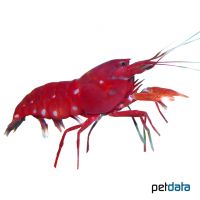Red Snapping Shrimp (Alpheus bisincisus)
| Red Snapping Shrimp Alpheus bisincisus | |
|---|---|
| Name | Red Snapping Shrimp |
| Name Lat. | Alpheus bisincisus |
| Family | Snapping Shrimps |
| Family lat. | Alpheidae |
| Order | Decapoda |
| Order lat. | Decapoda |
| Origin | Indo-Pacific |
| Diet | Omnivore |
| pH | 8.1-8.4 |
| Hardness | 8-12 °KH |
| Lighting | Medium |
| Current | Moderate |
| Behavior | Peaceful |
| Keeping | Individual, pair |
| Care Level | Moderate |
| Life Span | N/A |
| Protection | No |
| Metric Units | |
| Size | 8 cm |
| Temperature | 22-28 °C |
| Salinity | 33-36 ‰ |
| Aquarium | 100 l |
| US Units | |
| Size | 3.1" |
| Temperature | 72-82 °F |
| Salinity | 1.020-1.025 sg |
| Aquarium | 25 gal |
Distribution and habitat
The distribution area of Alpheus bisincisus is the Indian and Pacific Oceans, from Madagascar, Sri Lanka and Indonesia to southern Japan, New Caledonia and Australia. They live under stones, loose rubble, caves and in crevices.
Maintenance
They need a well-structured aquarium with a reef structure (crevices, caves, shelters) and stone slabs on sandy areas, with live stones that they can graze on (algae, small crustaceans) and that act like a biological filter. Tubes made of clay or plastic can also serve as living caves. The graveable substrate of fine to medium coral sand should be at least 10 cm deep. Only lime-rich, heavy metal-free substrates may be used as substrate. Filters, skimmers and heaters are necessary to ensure water quality, as well as pumps to simulate tides, swells and bottom currents. Lighting must match the species-appropriate day-night rhythm of the animals
| Salinity: 33-36 ‰ | pH value: 7.9-8.5 |
| Carbonate hardness: 6-10 °KH | Nitrate content: 2-8 mg/l |
| phosphate content: 0.01-0.1 mg/l | nitrite content: 0.0-0.05 mg/l |
Regular addition of trace elements, especially calcium, iodine and magnesium is recommended. For salinity, an average value should be aimed for, which may only vary slightly by +/- 0.5 ‰. Ammonia and ammonium must not be measurable. Special attention shall be paid to consistently good water quality and water values.
Diet
In the wild they feed on small invertebrates, detritus, algal growth and leaf algae. In a community tank, special feeding is only occasionally necessary, as they partake of fish food (small mysis, krill, artemia, bosmids, dry food, etc.). Once or twice a week, phyto- and zooplankton, available as ready-made food in specialized shops, should be offered.
Regular and varied feeding promotes health and increases resistance.
Behaviour and compatibility
They do not live in symbiosis with fish or other invertebrates, behave territorially and are very loyal to their location
Socialization with fish and invertebrates, by which they are not considered food, is very possible. However, smaller shrimp may be eaten.
Reproduction and breeding
The males usually have a larger bangscissors than the females. Reports about successful reproduction in the aquarium are not known
Important
They have an enlarged claw with which they can produce a very loud bang by closing extremely quickly (10 m/sec). This bang, which led to the name bang crab or gun crab, serves as a deterrent and also for communication among themselves. If this claw is lost, the opposite feeding claw grows into a new bang claw after 1-3 molts
They often build new passage systems in the rock, which prevents the limestones from caking and improves water circulation in the rock structure.
If the water values are not appropriate (e.g. iodine content), molting problems may occur.
Special care is required when placing them in the aquarium. They are very sensitive to different water conditions. Newly introduced animals must be accustomed slowly to the water in the aquarium.
If different species are kept together, care must be taken to ensure that fish and invertebrates match each other in terms of water quality and temperature requirements, as well as their social behavior, and that the setup meets the ecological needs of all species kept together
Further literature can be found in your pet store.
References
Text: Werner Winter; Image: petdata
Source: FOSSÁ & NILSEN (1995): Korallenriff-Aquarium Bd. 6, Birgit Schmettkamp Verlag; ENGELMANN & LANGE (2011): Zootierhaltung - Tiere in menschlicher Obhut: Wirbellose, Verlag Harri Deutsch
